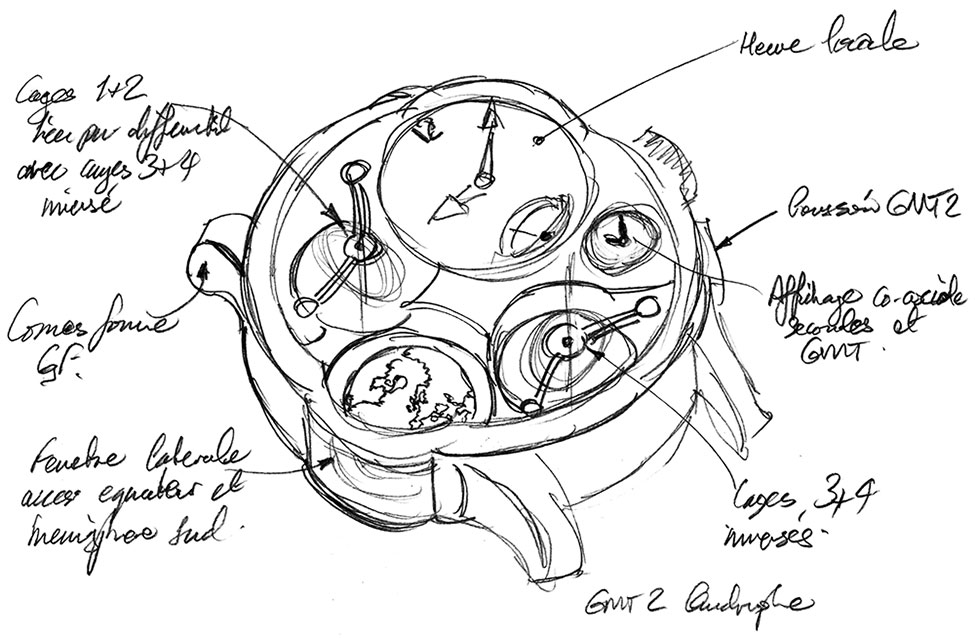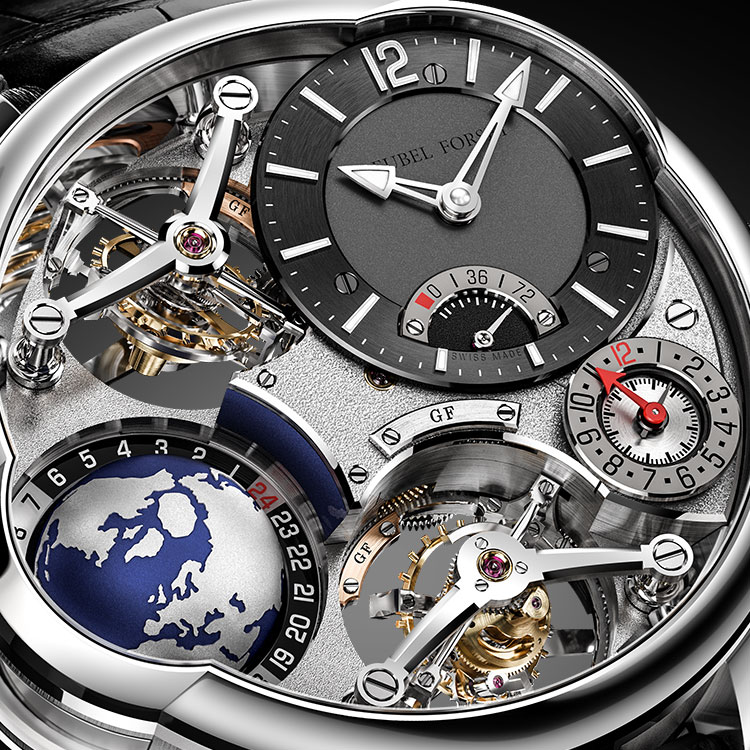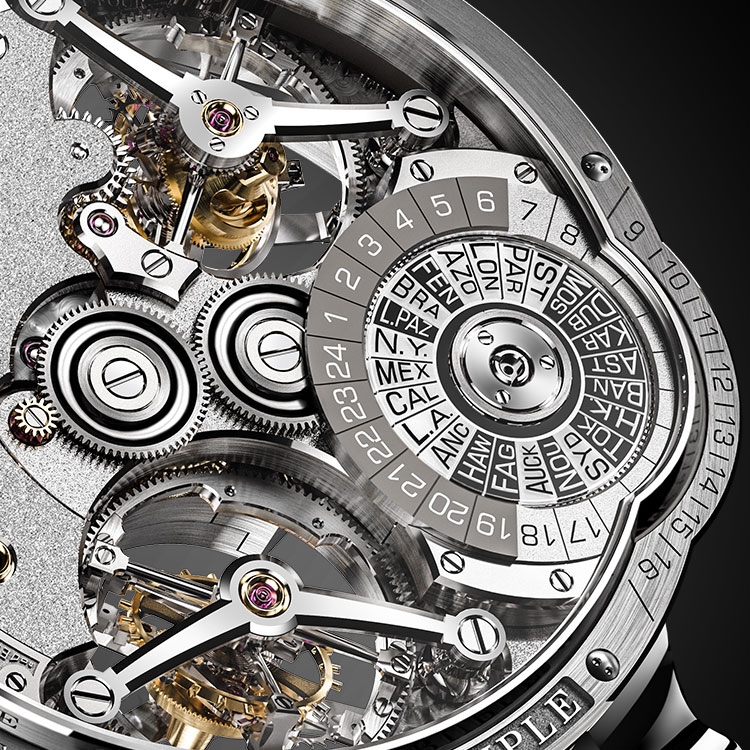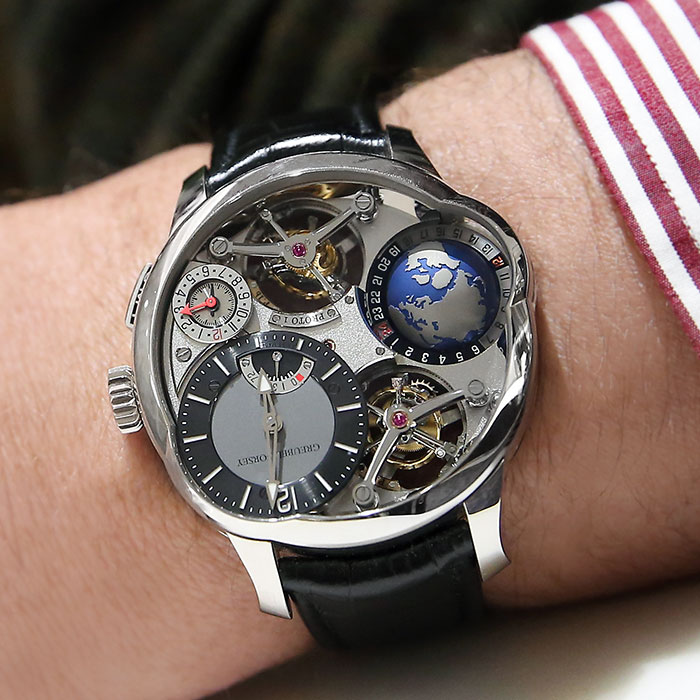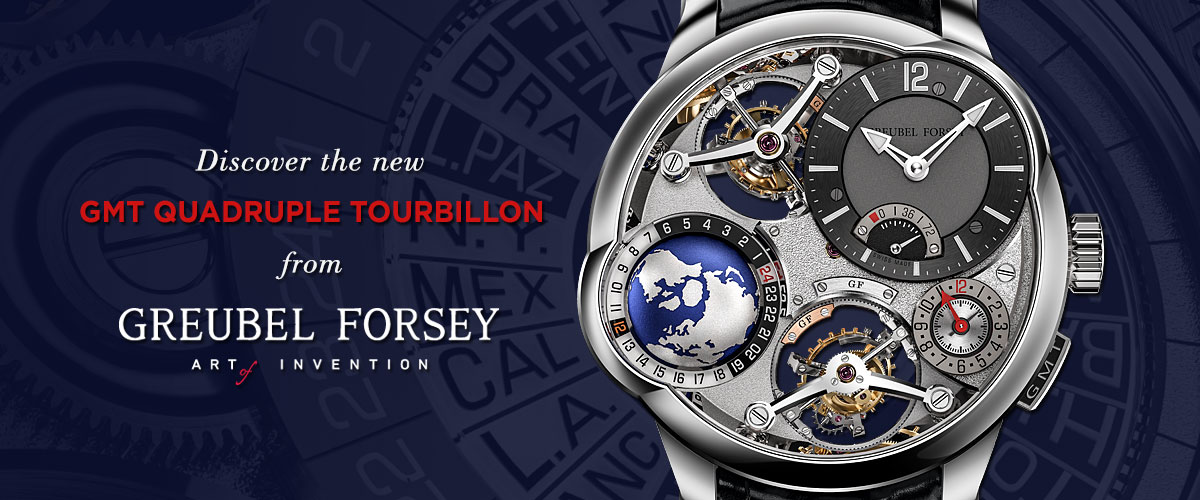
Greubel Forsey
Expanding Horizons
Greubel Forsey delivers a micromechanical tour de force with its GMT Quadruple Tourbillon, a substantial watch that is much more than the sum of its parts.
The GMT Quadruple Tourbillon may be new, but its roots stretch all the way back to 2004, the year Robert Greubel and Stephen Forsey released their first watch and patented plans for their quadruple tourbillon mechanism. That theory became a reality in 2008 when the brand unveiled its original Quadruple Tourbillon. The next generation quadruple tourbillon movement arrived in 2011 after Greubel Forsey revisited the concept and redesigned it for Invention Piece 2.
The latest evolution of the caliber was announced earlier this year. It widens the horological scope established in previous incarnations by adding Greubel Forsey’s signature GMT function to the mix. In late October, Forsey was at Cellini for a daylong event spotlighting the brand’s new releases, including the GMT Quadruple Tourbillon. We asked him about the origins of the watch and how it differs from previous incarnations.
A third quadruple tourbillon was always part of a larger plan, Forsey said. “A principle axis of our work at Greubel Forsey is research and development. And as you know, when you’re doing a scientific experiment, if you just do one exercise, you have a set of results, but you don’t really know where you stand. If you do two sets, you get a better view of what’s going on. And with three sets, you start to get a good look at the landscape,” he explained.
“The same is true when we when build a new mechanism,” he continued. “We want to build at least three of a particular mechanism; each one with a slight technical difference. That’s so we can study the impact of those differences, explore new ideas and ultimately evolve the design.
“After the first two models, we wanted to make a third to continue the research, but it had to make sense. We didn’t think collectors would be excited by our technical pursuits, so we had to think of something else; something that would be interesting for them, and challenging for us,” he said.
“That’s when the idea came for a watch that combined two of our most visually striking designs – the Quadruple Tourbillon and the GMT. That’s really the inspiration behind the GMT Quadruple Tourbillon,” Forsey said.
FINDING BALANCE
For the GMT Quadruple Tourbillon to resonate, Greubel Forsey needed to create a watch that brought together two highly complex functions in a way that was both cohesive and complementary.
The challenge, Forsey said, was finding the right balance. “It’s possible to have too much of a good thing. So, to avoid that kind of sensory overload, it was important to find a way for the technical elements to blend together and form something new.”
To appreciate the scope of that task, it’s helpful to understand the watch’s key horological elements.
First, the Quadruple Tourbillon movement stands out from most others because it has two regulating organs instead of one. Each oscillator – which is comprised of a balance wheel, hairspring, and escapement – is largely responsible for maintaining a steady timekeeping rate. In the Quadruple Tourbillon, two oscillators operate independently inside double tourbillons. Each of those has an inner cage – angled at 30 degrees – that rotates once every minute. It’s surrounded by a second cage that turns once every four minutes.
Calibrated to minimize the effects of gravity on chronometric precision, the dual-tourbillon design is based on years of Greubel Forsey’s extensive research into tourbillons in wristwatches. In the Quadruple Tourbillon, the dual tourbillons transmit their individual timing rates to a spherical differential. Designed by the brand, this sophisticated device averages both rates together to produce a more-precise measurement. Then, it indicates the results on the anthracite-colored dial.
GLOBAL PERSPECTIVE
The other fundamental horological component is the GMT, a bold interpretation of a travel watch that Greubel Forsey introduced in 2011. It’s easy to identify thanks to the large, rotating globe on the dial. More than an aesthetic feature, the globe is also a world timer. It indicates the hours in 24 major time zones simultaneously as the locations on the earth align with the hours on the GMT ring, which is black for night and white for day.
The sapphire-crystal window on the caseband of the asymmetrical white-gold case offers a view of the globe’s equator and the Southern Hemisphere. The window also orients you intuitively to the am/pm indication because the window lights the day side of the globe, while the night side faces away from the metaphorical sun.
The world times are also displayed on the back through a clear exhibition caseback. A ring inscribed with abbreviations for 24 major cities turns inside a 24-hour scale. The cities align with a number that represents the current local hour. For better precision, cities that utilize Daylight Saving Time (aka Summer Time) are shown with a polished backdrop. Those that don’t use the seasonal offset have a black background.
EXPANDING HORIZONS
In the GMT Quadruple Tourbillon, the two principle functions are expressed in a balanced arrangement on the three-dimensional dial. The architectural layout neatly accommodates the two double tourbillons, along with a rotating globe.
While the operation of the functions hasn’t changed, a few aesthetic adjustments were made to maximize real estate on the dial. For instance, the double tourbillons have been relocated for the first time to the 11 o’clock and 6 o’clock positions. The small seconds and GMT hand have been combined into one subdial at 4 o’clock. Additionally, the size of the GMT’s original 24-city wheel has been reduced to make room for the tourbillons.
Surprisingly, adding more horological firepower didn’t require the watch to grow significantly. At 46.5mm, the diameter of the GMT Quadruple Tourbillon is only 3mm wider than the original GMT. “When you consider all the things going on mechanically with the watch, it’s incredible when you realized that everything it needs to operate is centralized within the relatively small area located under time display,” Forsey said.
Among watch enthusiasts, Greubel Forsey is celebrated for taking extraordinary measures to attain a superlative-level of hand finishing in all its watches. The GMT Quadruple Tourbillon is no exception. Along with the frosted surfaces and beveled edges, all four tourbillon bridges have been finished to an extremely high level to achieve the company’s trademark black polish.
The first incarnation of the GMT Quadruple Tourbillon will be produced in a white-gold case and released as an 11-piece limited edition. It is available now through Cellini Jewelers.
Click here to view the Greubel Forsey collection online at Cellini Jewelers.


